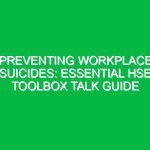Introduction
Safety issues at work encompass a range of concerns that affect the health, safety, and well-being of employees across various industries. In the realm of Health, Safety, and Environment (HSE), these issues are not merely operational hurdles but critical factors that can determine the success and Sustainability of any organization. From workplace accidents to exposure to hazardous materials, the implications of neglecting Safety concerns can be dire. This article delves deep into the essential Safety issues at work, offering insights, regulations, and practical advice for organizations keen on protecting their workforce and promoting a culture of safety.
Understanding Safety Issues at Work
Safety issues at work can manifest in numerous ways, and understanding them requires a comprehensive approach. Common safety Hazards include:
- Physical Hazards: These involve environmental factors that can cause harm, such as machinery, noise, and falling objects.
- Chemical Hazards: Exposure to harmful substances, whether through inhalation, skin contact, or ingestion, falls under this category.
- Biological Hazards: This includes exposure to bacteria, viruses, and other pathogens that can affect health.
- Ergonomic Hazards: Poor workplace design can lead to musculoskeletal disorders and other health issues.
- Psychosocial Hazards: Stress, harassment, and workplace bullying can significantly impact mental health.
Recognizing these hazards is the first step toward effective risk management. In an ideal workplace, employees should feel safe, valued, and able to perform their tasks without fear of injury or health risks.
Key Components of Workplace Safety
To effectively address safety issues at work, organizations must incorporate several key components into their safety management systems:
1. Risk Assessment and Management
Conducting regular risk assessments is crucial. This involves identifying potential hazards, evaluating the risks associated with them, and determining appropriate Control Measures. For example, a construction site may assess the risk of falls from heights and implement safety harnesses and guardrails as preventative measures.
2. Safety Training and Education
Proper training ensures that employees are aware of the hazards they may encounter and know how to mitigate these risks. Training should be ongoing and tailored to the specific needs of different roles within the organization. For instance, employees handling hazardous chemicals should receive specialized training on safe handling Procedures and emergency response actions.
3. Emergency Preparedness
Every workplace should have a clear emergency plan in place. This includes procedures for evacuations, first aid, and communication during a crisis. Regular drills can help ensure that all employees are familiar with these procedures.
4. Reporting Mechanisms
Encouraging an environment where employees can report safety concerns without fear of retaliation is vital. Organizations should establish easy-to-use reporting systems that allow employees to communicate hazards or unsafe practices promptly.
5. Continuous Improvement
Safety is not a one-time effort but a continuous process. Organizations should regularly review and update their safety protocols, taking into consideration new Regulations, technologies, and employee feedback.
Real-Life Examples of Safety Issues at Work
Consider the case of a manufacturing plant that experienced a significant accident due to inadequate Safety Measures. An employee was severely injured when a machine malfunctioned. The subsequent investigation revealed that the machine had not been properly maintained, and the employees had not received adequate training on its safe Operation. This incident not only resulted in physical harm but also led to financial losses and damage to the company’s reputation.
In contrast, a tech startup implemented a robust safety program that included ergonomic assessments of workstations, mental health resources, and regular safety training. As a result, they reported lower absenteeism rates, higher employee satisfaction, and a significant decrease in workplace injuries.
These examples highlight the profound impact that safety issues at work can have on both employees and organizations as a whole.
Regulations and Standards Governing Workplace Safety
Understanding the regulatory framework surrounding safety issues at work is essential for compliance and risk management. Various national and international standards guide organizations in ensuring Workplace Safety:
1. Occupational Safety and Health Administration (OSHA)
In the United States, osha sets and enforces protective Workplace Safety and health standards. Employers are required to provide a workplace free from serious hazards and comply with standards, rules, and regulations issued under the Occupational Safety and Health Act.
2. International Organization for Standardization (ISO)
ISO 45001 is an international standard that specifies requirements for an Occupational Health and safety (OH&S) management system, with guidance for its use. Its goal is to enhance employee safety, reduce workplace risks, and create better, safer working conditions.
3. Health and Safety at Work Act 1974 (UK)
This legislation outlines the general duties of employers to ensure the health, safety, and welfare of their employees. It emphasizes the importance of risk assessments and the need for effective safety communication within the workplace.
Compliance with these regulations not only protects employees but also shields organizations from potential legal liabilities and enhances their reputation.
Best Practices for Enhancing Workplace Safety
To effectively tackle safety issues at work, organizations can adopt several Best Practices:
1. Foster a Safety Culture
Creating a workplace culture that prioritizes safety at all levels encourages employees to take ownership of their safety and that of their colleagues. Leadership should model safety behaviors and support initiatives that promote safety awareness.
2. Invest in Safety Equipment
Providing the right Personal Protective Equipment (PPE) is fundamental. Organizations should ensure that employees have access to appropriate Safety Gear and that they are trained to use it correctly.
3. Conduct Regular Audits
Regular safety audits can help identify potential hazards and evaluate the effectiveness of existing Safety Measures. These audits should be thorough and involve input from employees at all levels.
4. Encourage Employee Involvement
Involving employees in safety discussions and decision-making fosters a sense of ownership. This can include safety committees, suggestion boxes, and regular feedback sessions.
5. Utilize Technology
Emerging technologies can enhance workplace safety. For instance, wearable devices can monitor employee health and safety in real-time, while software solutions can streamline safety reporting and communication.
Conclusion
Navigating safety issues at work is a multifaceted challenge that requires commitment, awareness, and proactive measures. By understanding the various types of hazards, adhering to regulations, and fostering a culture of safety, organizations can protect their workforce and enhance productivity. The importance of addressing safety issues at work cannot be overstated—it not only safeguards employees but also contributes to the overall success of the organization.
As we move forward, it’s crucial for businesses to prioritize safety in every aspect of their operations. The well-being of employees should be at the forefront, leading to a healthier, happier, and more productive workplace. In doing so, organizations will not only comply with legal requirements but also create an environment where employees feel valued and secure. Protect your workforce now, and reap the Benefits of a robust safety culture for years to come.


